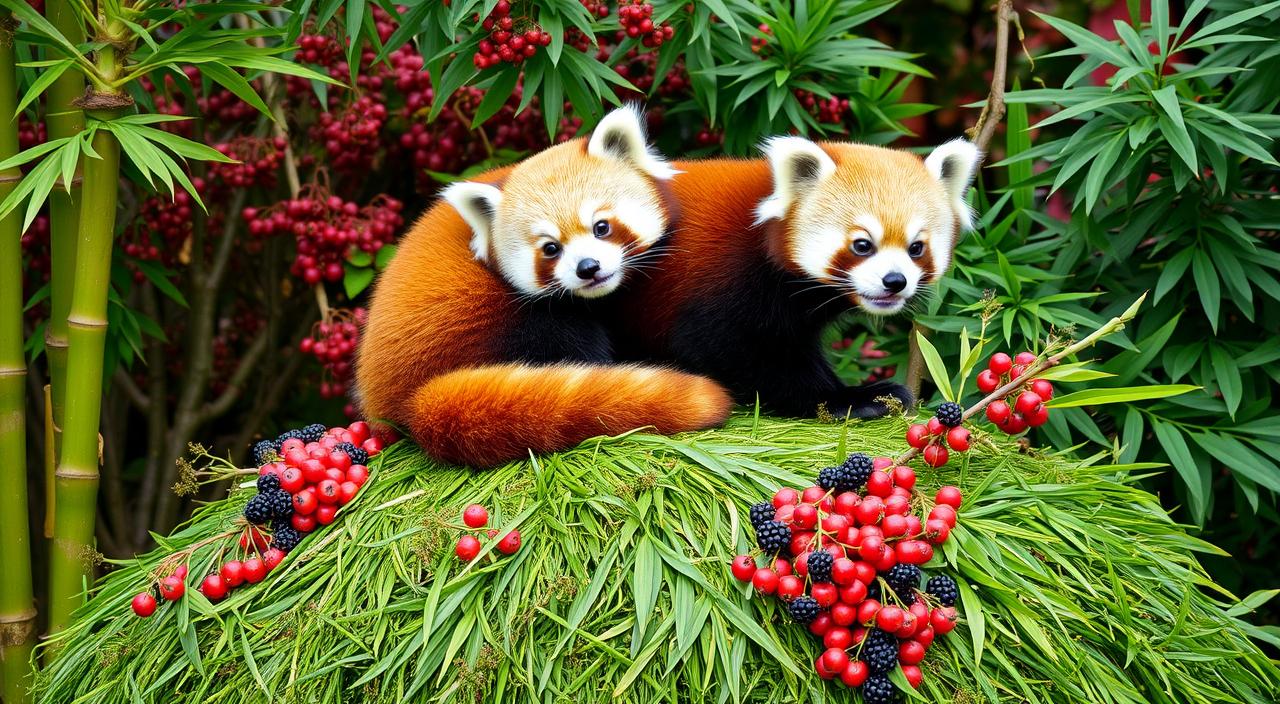Red Panda Food: The red panda, also known as the Ailurus fulgens, is an endangered species. It is legally protected in several countries across Asia. The San Diego Zoo Wildlife Alliance says the red panda population has dropped by 40% in the last 20 years. This decline is expected to continue.
Habitat loss and degradation, human interference, and poaching are the main threats. Logging, livestock grazing, and demand for firewood are big reasons for habitat loss. Human encroachment and farming also play a role.
Fragmentation of their habitat has led to inbreeding. This is because populations are becoming more isolated. Despite these challenges, the Smithsonian’s National Zoo and Conservation Biology Institute has made progress. They have helped over 100 red panda cubs survive since 1962.
The International Union for Conservation of Nature (IUCN) has set priorities for red panda conservation. They focus on protecting habitats, reducing degradation, preventing deaths, and raising awareness. These efforts aim to ensure the long-term survival of this unique species.
Key Takeaways
- Red pandas are an endangered species with a population decline of 40% over the past two decades.
- Habitat loss, degradation, and human interference are the primary threats to red pandas.
- Conservation efforts by organizations like the Smithsonian’s National Zoo have helped conserve red pandas.
- The IUCN has identified four key areas for red panda conservation, including protecting habitat and reducing deaths.
- Red pandas are legally protected in several Asian countries due to their endangered status.
A Specialized Bamboo Diet
Red pandas have a special bond with bamboo, making up 98% of their diet. They need to eat 20-30% of their body weight in bamboo leaves and shoots daily. This might seem like a lot, but their unique body helps them survive on bamboo in the cloud forests they live in.
Bamboo Forms 98% of Red Panda’s Diet
Red pandas are experts at eating bamboo, which makes up 95-98% of their diet. They love the leaf tips and shoots of bamboo, especially Bashania faberi. This shows how well they’ve adapted to their mountain homes and the bamboo that grows there.
Eat 20-30% of Their Body Weight in Bamboo Leaves Daily
Red pandas need to eat a lot of bamboo to stay healthy. A female can eat up to 20,000 bamboo leaves a day. Even though bamboo isn’t very calorie-rich, they spend a lot of time finding and eating it.
But bamboo isn’t the only thing on their menu. They also eat roots, grass, fruits, acorns, small insects, bird eggs, and small rodents. This varied diet helps them survive in their mountain habitats.
“Red pandas are true specialists when it comes to their diet, with bamboo accounting for a remarkable 95-98% of their food intake.”
Unique Adaptations for Bamboo Consumption
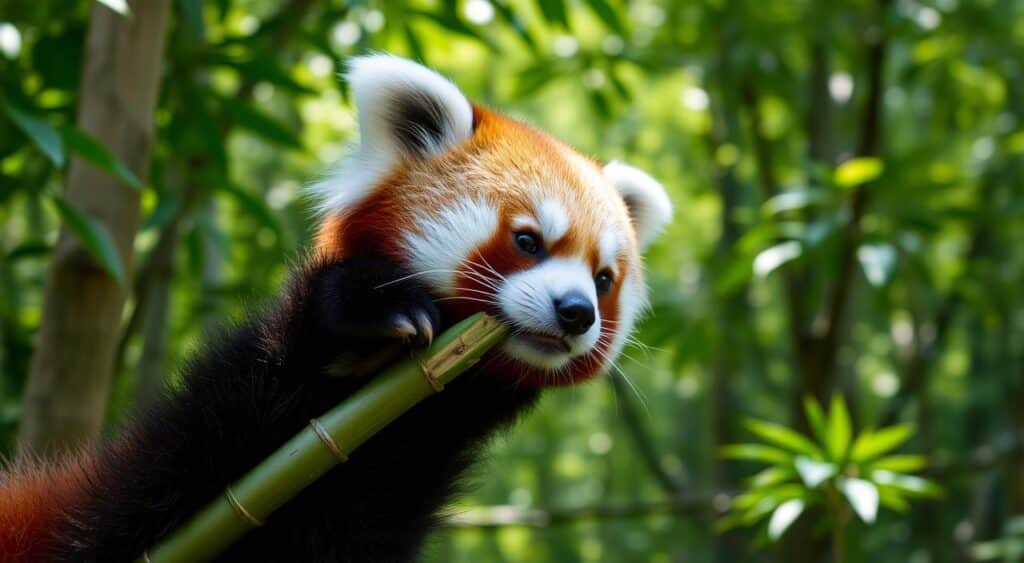
The red panda (Ailurus fulgens) has evolved special traits for eating bamboo. Its “pseudo-thumb” is a key feature. It’s an enlarged wrist bone that lets the panda climb and hold onto bamboo stems well. This shows how two different species, the red panda and the giant panda, have similar traits for eating bamboo.
Pseudo-Thumb for Grabbing Bamboo Stems
The red panda’s pseudo-thumb is like an opposable thumb. It’s a modified wrist bone that helps the panda hold onto bamboo tightly. This is important for the red panda to get leaves and shoots from bamboo stems. These make up 95% of its diet.
Carnivore Ancestry but Herbivorous Diet
Even though they eat herbivorous food, red pandas are actually carnivores. They come from a carnivorous, tree-dwelling relative called Simocyon batalleri. This relative was as big as a mountain lion and lived long ago. The red panda’s ability to eat mostly bamboo is quite unique among carnivores.
“Red pandas have evolved unique adaptations to support their specialized bamboo diet, including a ‘pseudo-thumb’ that helps them grasp and manipulate the tough bamboo stems.”
Red Panda Food: A Vital Ecological Role
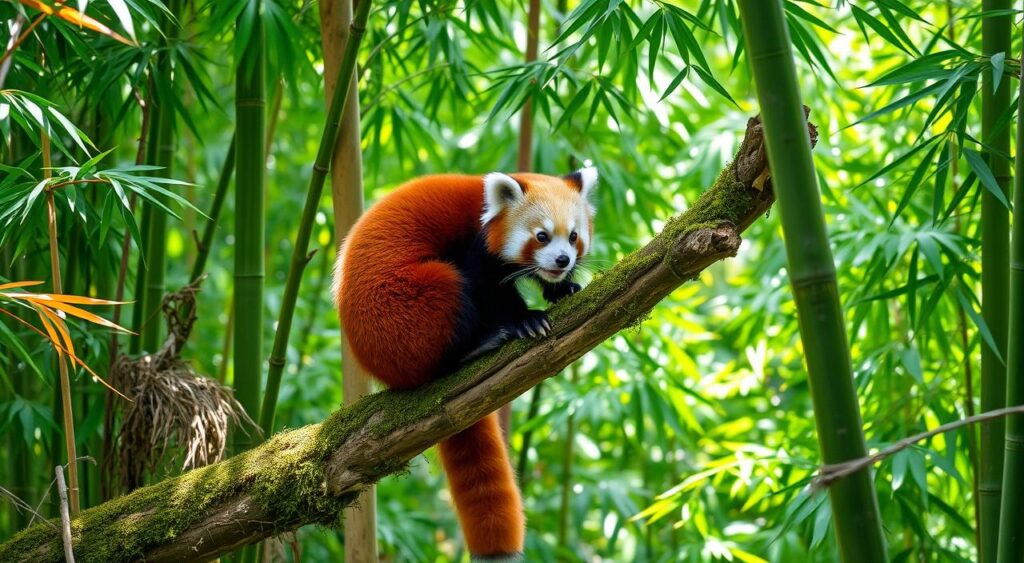
The red panda is a remarkable creature that plays a vital ecological role in the Eastern Himalayan Broadleaf Forest Ecoregion. This region is home to over 500 million people. It supports a diverse array of flora and fauna. The red panda is a true flagship species and indicator species for the ecosystem’s health.
Red pandas have a specialized diet and habitat needs. They are key to the balance in this critical region. Up to 95% of their diet is bamboo. This helps in the regeneration and diversity of bamboo species through seed dispersal.
This benefits the entire Eastern Himalayan Broadleaf Forest Ecoregion by promoting forest growth and rejuvenation. By conserving the red panda and its habitat, we protect this unique species. We also safeguard the entire ecosystem and its invaluable biodiversity.
The red panda’s role as a flagship species means its conservation efforts benefit more than just the animal. It serves as a beacon for the preservation of the entire Eastern Himalayan Broadleaf Forest Ecoregion.
“The red panda is a true ambassador for the conservation of the Eastern Himalayan Broadleaf Forest Ecoregion, a region that is vital for the well-being of millions of people and the survival of countless other species.”
| Ecological Significance | Red Panda’s Role |
|---|---|
| Biodiversity Hotspot | Flagship and Indicator Species |
| Habitat for Over 500 Million People | Bamboo Regeneration and Seed Dispersal |
| Eastern Himalayan Broadleaf Forest Ecoregion | Vital for Ecosystem Balance and Conservation |
Red Panda Conservation and Habitat Loss
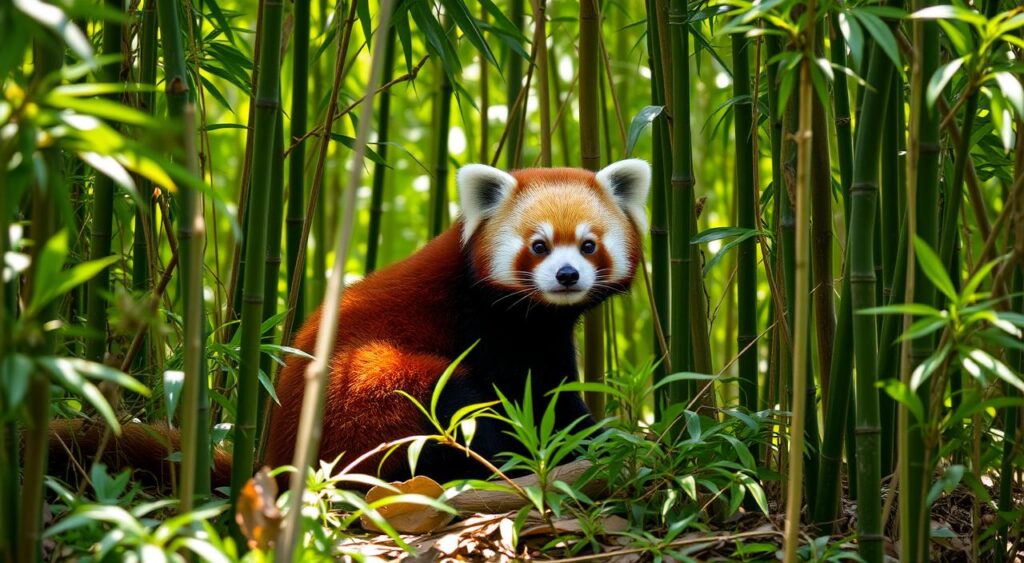
The red panda is a fascinating creature with its reddish-brown fur and unique markings. Sadly, it faces many dangers. With only about 10,000 left in the wild, the main issue is the loss of their homes.
Declining Populations Due to Habitat Degradation
In the last 20 years, the red panda’s numbers have dropped by 40%. Logging, livestock, and farming are big problems. Human activities like firewood gathering and encroachment also hurt their homes. The red pandas are getting too close to each other, leading to health issues.
Illegal hunting and the pet trade have made things worse. Climate change and natural disasters have also harmed them. The Eastern Himalayas, where many red pandas live, is especially vulnerable to climate change.
Protected Areas and Community-Based Initiatives
- China has created 46 protected areas, covering about 65% of the red panda’s home in the country.
- India, Bhutan, and Myanmar have also made protected areas for red pandas. They have 19, 5, and 3 areas, respectively.
- Groups like the Red Panda Network are working to connect habitats and involve local people in conservation.
- In Nepal, the WWF helps yak herders sell yak dung briquettes. This reduces harm to the red panda’s habitat.
Despite the challenges, the work of conservation groups, governments, and communities is key. Protecting the red panda’s habitat and tackling the threats they face is essential. This way, we can help this special animal survive.
Fascinating Red Panda Facts
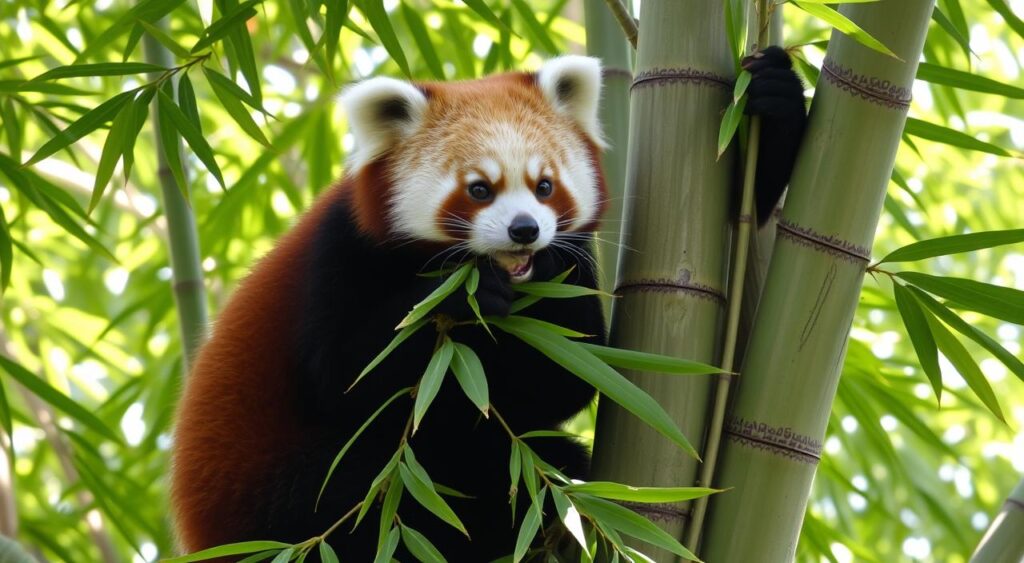
Red pandas, also known as the “firefox” or “red bear-cat,” are fascinating creatures. They were discovered nearly 50 years before the giant pandas. In 1825, French naturalist Frédéric Cuvier first described them. He thought they were the most beautiful animals he had ever seen.
Despite their name, red pandas are not related to giant pandas. Recent studies show they are more like raccoons and weasels. This was confirmed in 1897 by F.W. Styan, who found another subspecies, Ailurus fulgens styani.
The First Panda Discovered
The red panda, known as Ailurus fulgens fulgens and Ailurus fulgens styani, was the first panda found by scientists. It was discovered nearly half a century before the giant panda. Georges-Frédéric Cuvier, a French zoologist, first described them in 1825.
Not Related to Giant Pandas
Red pandas are not related to giant pandas, despite their similar looks. They are found in Asia, but genetic studies show they belong to the raccoon and weasel families. This is different from the giant panda, which is a bear.
“The red panda, with its striking reddish-brown fur, black-and-white markings, and fluffy tail, is a true marvel of nature.”
Survival Strategies and Behaviors
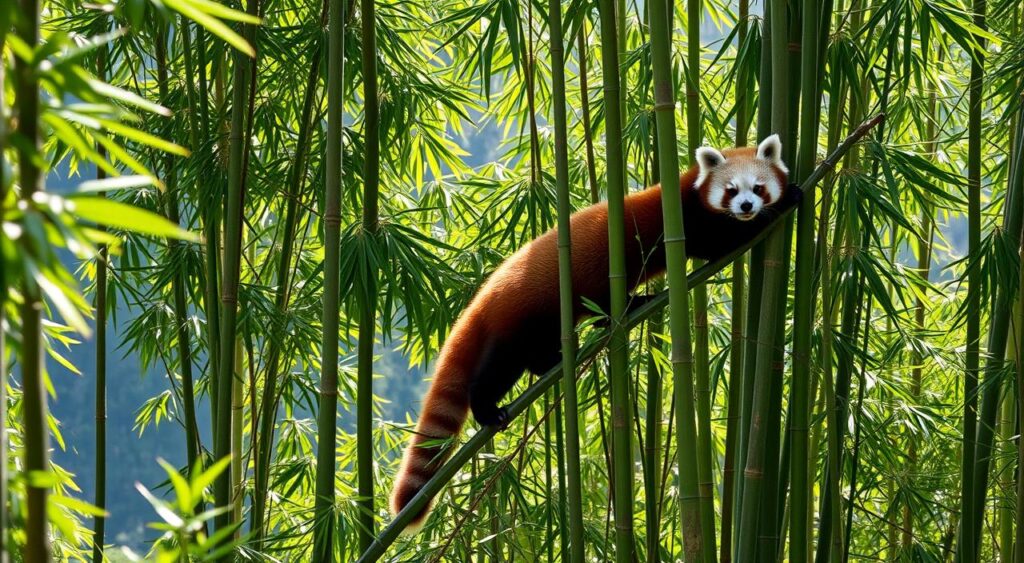
Red pandas have special ways to survive in their high-altitude homes. They can slow down their body’s work and sleep deeply, called torpor. This helps them save energy when food is hard to find.
Lowering Metabolic Rate and Torpor
Red pandas sleep up to 17 hours a day. They use torpor to use less energy. This lets them survive when food is scarce in the mountains.
By slowing down, they can go longer without eating. This is key in their limited resource world.
Vertical Migration Patterns
Red pandas also move up and down mountains. In winter, they go lower to find more food and avoid cold. This move helps them deal with changing food and weather.
Through these strategies, red pandas thrive in their challenging habitats. Their unique survival methods are vital for their survival. These behaviors are important for keeping this amazing species safe.
Also Read: Why Pandas Love Bamboo: A Closer Look at Their Eating Habits
Conclusion
The red panda is an amazing creature. It has adapted to a diet based on bamboo and lives in high-altitude forests. Its special features, like the pseudo-thumb, help it survive on mostly plants. Red pandas are important for their ecosystems and need our protection.
But, red pandas are in danger due to lost habitats and human actions. Their numbers are going down, which worries us all. Yet, there are efforts to save them. The Red Panda Network, for example, uses local people to protect these animals.
To keep the red panda safe, we must learn more about them. Studying their behavior and habitats is key. This knowledge helps us find better ways to save them. Saving the red panda shows us nature’s strength and our duty to protect it.
FAQs
Q: What do red pandas eat in zoos?
A: In zoos, red pandas eat a diet that primarily consists of bamboo shoots and leaves, which closely resembles their natural diet in the wild.
Q: Why do red pandas eat bamboo?
A: Red pandas eat bamboo because it is a nutritious food source that provides the necessary calories and nutrients needed to maintain their health, despite being low in protein.
Q: What types of bamboo do red pandas prefer?
A: Red pandas prefer young, tender bamboo shoots and leaves, which are more nutritious and easier for them to digest.
Q: How much bamboo do red pandas eat daily?
A: Red pandas may eat up to 20 to 30 percent of their body weight in bamboo each day to meet their dietary needs.
Q: Where is the native habitat of red pandas?
A: The native habitat of red pandas includes temperate forests in the Himalayas and other areas of Asia, where they can find ample bamboo to eat.
Q: How do red pandas obtain nutrients from bamboo?
A: Red pandas have evolved specialized digestive systems that allow them to extract nutrients from bamboo, although they still require a large quantity to meet their energy needs.
Q: Are red pandas related to giant pandas?
A: Yes, red pandas are closely related to the giant panda, but they belong to different families. Unlike giant pandas, red pandas are more closely related to raccoons than bears.
Q: What are some interesting facts about red pandas and their diet?
A: Red pandas are known for their bushy tails and playful behavior. They mainly eat bamboo, but they may also consume fruits, berries, and small mammals to supplement their diet.
Q: How do environmental factors affect the distribution and habitat of red pandas?
A: The distribution and habitat of red pandas are affected by climate change and deforestation, which impact their bamboo food sources and overall survival in the wild.

